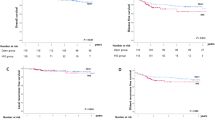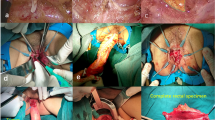Abstract
Aim of this study was to compare operative, long-term oncological and functional outcomes of laparoscopic (LISR) and robotic (RISR) intersphincteric resection in low-lying rectal cancer. Retrospective analysis of prospectively maintained database was performed. 115 cases (LISR, n = 55; RISR, n = 60) were performed by a single surgeon (January 2011–January 2020). Clinical characteristics did not differ between the groups. Operating time was longer in RISR (160.0 ± 45.7 vs. 205.0 ± 36.5 min, p = 0.035). There was no conversion in RISR, whereas in LISR, two patients (3.6%) converted to open surgery. Complete mesorectum was 61.8% and 83.3% for LISR and RISR (p = 0.046), respectively. Circumferential radial margin involvement was 10.9% and 8.3% in LISR and RISR (p = 0.365), respectively. Median follow-up was 82.8 (30–138) months for LISR and 83.6 (30–138) months for RISR. Three-, five-, and seven-year overall survival rates (OS) for LISR and RISR were: 88.6%, 80.4%, 73.4% and 90.4%, 86.3%, 76.9%, respectively. Three-, five-, and seven-year disease-free survival (DFS) rates for LISR and RISR were 80.5%, 75.2%, 70.4% and 84.4%, 81.4%, 79.8% (p = 0.328), respectively. Three-, five-, and seven-year local recurrence-free survival rates in LISR and RISR were: 96.1%, 92.6%, 88.4% and 96.7%, 94.2%, 90.4% (p = 0.573), respectively. Mean Wexner score for LISR (n = 32) and RISR (n = 40) was: 10.5 ± 4.7 and 9.8 ± 4.2 (p = 0.782), respectively. Colostomy-free survival in LISR and RISR was: 3 years 94.5%/95.2%, 5 years 89.1%/91.7%, and 7 years 83.6%/85.0%. RISR is associated with better mesorectal integrity, no conversion, and lower postoperative complication rate. RISR has longer operation time. Oncological and anorectal functional outcomes are similar in both groups.


Similar content being viewed by others
References
Schiessel R, Karner-Hanusch J, Herbst F, Teleky B, Wunderlich M (1994) Intersphincteric resection for low rectal tumours. Br J Surg 81:1376–1378
Piozzi GN, Baek SJ, Kwak JM, Kim J, Kim SH (2021) Anus-preserving surgery in advanced low-lying rectal cancer: a perspective on oncological safety of intersphincteric resection. Cancers 13:4793
Piozzi GN, Lee TH, Kwak JM, Kim J, Kim SH (2021) Robotic-assisted resection for beyond TME rectal cancer: a novel classification and analysis from a specialized center. Updates Surg 73:1103–1114
Piozzi GN, Park H, Kim JS, Choi HB, Lee TH, Baek SJ et al (2021) Anatomical landmarks for transabdominal robotic-assisted intersphincteric dissection for ultralow anterior resection. Dis Colon Rectum 64(5):e87–e88
Piozzi GN, Park H, Choi TS, Kim SH (2020) Intersphincteric resection for low rectal cancer: a review on anatomy and surgical technique, oncologic and functional outcomes and the role of robotics. Turk J Colorectal Dis 30:76–85
Piozzi GN, Kim SH (2021) Robotic intersphincteric resection for low rectal cancer: technical controversies and a systematic review on the perioperative, oncological, and functional outcomes. Ann Coloproctol 37:351–367
Rullier E, Laurent C, Bretagnol F, Rullier A, Vendrely V, Zerbib F (2005) Sphincter-saving resection for all rectal carcinomas: the end of the 2-cm distal rule. Ann Surg 241:465–469
Piozzi GN, Park H, Lee TH, Kim JS, Choi HB, Baek SJ et al (2021) Risk factors for local recurrence and long term survival after minimally invasive intersphincteric resection for very low rectal cancer: multivariate analysis in 161 patients. Eur J Surg Oncol 47:2069–2077
Luca F, Valvo M, Guerra-Cogorno M, Simo D, Blesa-Sierra E, Biffi R et al (2016) Functional results of robotic total intersphincteric resection with hand-sewn coloanal anastomosis. Eur J Surg Oncol 42:841–847
Kim JC, Lee JL, Bong JW, Seo JH, Kim CW, Park SH et al (2019) Oncological and anorectal functional outcomes of robot-assisted intersphincteric resection in lower rectal cancer, particularly the extent of sphincter resection and sphincter saving. Surg Endosc 34(5):2082–2094
Park JS, Park SY, Kim HJ, Cho SH, Kwak SG, Choi GS (2019) Long-term oncologic outcomes after neoadjuvant chemoradiation followed by intersphincteric resection with coloanal anastomosis for locally advanced low rectal cancer. Dis Colon Rectum 62:408–416
Guillou PJ, Quirke P, Thorpe H, Walker J, Jayne DG, Smith AM et al (2005) Short-term endpoints of conventional versus laparoscopic-assisted surgery in patients with colorectal cancer (MRC CLASICC trial): multicentre, randomised controlled trial. Lancet 365:1718–1726
Kang SB, Park JW, Jeong SY, Nam BH, Choi HS, Kim DW et al (2010) Open versus laparoscopic surgery for mid or low rectal cancer after neoadjuvant chemoradiotherapy (COREAN trial): short-term outcomes of an open-label randomised controlled trial. Lancet Oncol 11:637–645
van der Pas MH, Haglind E, Cuesta MA, Furst A, Lacy AM, Hop WC et al (2013) Laparoscopic versus open surgery for rectal cancer (COLOR II): short-term outcomes of a randomised, phase 3 trial. Lancet Oncol 14:210–218
Aliyev V, Goksel S, Bakir B, Guven K, Asoglu O (2021) Sphincter-saving robotic total mesorectal excision provides better mesorectal specimen and good oncological local control compared with laparoscopic total mesorectal excision in male patients with mid-low rectal cancer. Surg Technol Int 38:160–166
Kim JC, Lee JL, Alotaibi AM, Yoon YS, Kim CW, Park IJ (2017) Robot-assisted intersphincteric resection facilitates an efficient sphincter-saving in patients with low rectal cancer. Int J Colorectal Dis 32:1137–1145
Aliyev V, Tokmak H, Goksel S, Meric S, Acar S, Kaya H et al (2020) The long-term oncological outcomes of the 140 robotic sphincter-saving total mesorectal excision for rectal cancer: a single surgeon experience. J Robot Surg 14:655–661
Aliyev V, Goksoy B, Goksel S, Guven K, Bakir B, Saglam S et al (2021) Intersphincteric resection for low rectal cancer: parameters affecting functional outcomes and survival rates. Surg Technol Int 39:166–172
Weiser MR (2018) AJCC 8th edition: colorectal cancer. Ann Surg Oncol 25:1454–1455
Quirke P, Steele R, Monson J, Grieve R, Khanna S, Couture J et al (2009) Effect of the plane of surgery achieved on local recurrence in patients with operable rectal cancer: a prospective study using data from the MRC CR07 and NCIC-CTG CO16 randomised clinical trial. Lancet 373:821–828
Nagtegaal ID, Marijnen CA, Kranenbarg EK, van de Velde CJ, van Krieken JH, Pathology Review C et al (2002) Circumferential margin involvement is still an important predictor of local recurrence in rectal carcinoma: not one millimeter but two millimeters is the limit. Am J Surg Pathol 26:350–357
Dindo D, Demartines N, Clavien PA (2004) Classification of surgical complications: a new proposal with evaluation in a cohort of 6336 patients and results of a survey. Ann Surg 240:205–213
Rahbari NN, Weitz J, Hohenberger W, Heald RJ, Moran B, Ulrich A et al (2010) Definition and grading of anastomotic leakage following anterior resection of the rectum: a proposal by the International Study Group of Rectal Cancer. Surgery 147:339–351
von Elm E, Altman DG, Egger M, Pocock SJ, Gotzsche PC, Vandenbroucke JP et al (2008) The strengthening the reporting of observational studies in epidemiology (STROBE) statement: guidelines for reporting observational studies. J Clin Epidemiol 61:344–349
Jorge JM, Wexner SD (1993) Etiology and management of fecal incontinence. Dis Colon Rectum 36:77–97
Kirwan WO, Turnbull RB Jr, Fazio VW, Weakley FL (1978) Pullthrough operation with delayed anastomosis for rectal cancer. Br J Surg 65:695–698
Rullier E, Sa Cunha A, Couderc P, Rullier A, Gontier R, Saric J (2003) Laparoscopic intersphincteric resection with coloplasty and coloanal anastomosis for mid and low rectal cancer. Br J Surg 90:445–451
Fujimoto Y, Akiyoshi T, Kuroyanagi H, Konishi T, Ueno M, Oya M et al (2010) Safety and feasibility of laparoscopic intersphincteric resection for very low rectal cancer. J Gastrointest Surg 14:645–650
Chen H, Ma B, Gao P, Wang H, Song Y, Tong L et al (2017) Laparoscopic intersphincteric resection versus an open approach for low rectal cancer: a meta-analysis. World J Surg Oncol 15:229
Laurent C, Paumet T, Leblanc F, Denost Q, Rullier E (2012) Intersphincteric resection for low rectal cancer: laparoscopic vs open surgery approach. Colorectal Dis 14:35–41 (discussion 2-3)
Lee SH, Kim DH, Lim SW (2018) Robotic versus laparoscopic intersphincteric resection for low rectal cancer: a systematic review and meta-analysis. Int J Colorectal Dis 33:1741–1753
Baek SJ, Piozzi GN, Kim SH (2021) Optimizing outcomes of colorectal cancer surgery with robotic platforms. Surg Oncol 37:101559
Baek SJ, Al-Asari S, Jeong DH, Hur H, Min BS, Baik SH et al (2013) Robotic versus laparoscopic coloanal anastomosis with or without intersphincteric resection for rectal cancer. Surg Endosc 27:4157–4163
Shen Y, Yang T, Yang J, Meng W, Wang Z (2020) Intraoperative indocyanine green fluorescence angiography to prevent anastomotic leak after low anterior resection for rectal cancer: a meta-analysis. ANZ J Surg 90:2193–2200
Yoo BE, Cho JS, Shin JW, Lee DW, Kwak JM, Kim J et al (2015) Robotic versus laparoscopic intersphincteric resection for low rectal cancer: comparison of the operative, oncological, and functional outcomes. Ann Surg Oncol 22:1219–1225
Park JS, Kim NK, Kim SH, Lee KY, Lee KY, Shin JY et al (2015) Multicentre study of robotic intersphincteric resection for low rectal cancer. Br J Surg 102:1567–1573
Kazi M, Jajoo B, Rohila J, Dohale S, Bhuta P, Desouza A et al (2022) Functional outcomes after robotic or laparoscopic intersphincteric resection - an inverse probability weighting analysis. Eur J Surg Oncol. https://doi.org/10.1016/j.ejso.2022.07.009
Denost Q, Moreau JB, Vendrely V, Celerier B, Rullier A, Assenat V et al (2020) Intersphincteric resection for low rectal cancer: the risk is functional rather than oncological. A 25-year experience from Bordeaux. Colorectal Dis 22:1603–1613
Acknowledgements
We would like to express our gratitude to Aslan Aliyev (Eberhard Karls University, Germany) for his contribution to the statistical analysis.
Author information
Authors and Affiliations
Contributions
Conceptualization: VA and OA; methodology: OA and VA; formal analysis and investigation: VA and GNP; writing—original draft preparation: VA, GNP, and AB; writing—review and editing: VA, GNP, KG, BB, SS, and SG; supervision: OA.
Corresponding author
Ethics declarations
Conflict of interest
The authors declare no conflict of interest do disclose.
Ethical approval
Institutional Review Board (IRB) approval was waived following the retrospective nature of the study.
Informed consent
Informed consent was obtained from each patient.
Additional information
Publisher's Note
Springer Nature remains neutral with regard to jurisdictional claims in published maps and institutional affiliations.
Rights and permissions
Springer Nature or its licensor holds exclusive rights to this article under a publishing agreement with the author(s) or other rightsholder(s); author self-archiving of the accepted manuscript version of this article is solely governed by the terms of such publishing agreement and applicable law.
About this article
Cite this article
Aliyev, V., Piozzi, G.N., Bulut, A. et al. Robotic vs. laparoscopic intersphincteric resection for low rectal cancer: a case matched study reporting a median of 7-year long-term oncological and functional outcomes. Updates Surg 74, 1851–1860 (2022). https://doi.org/10.1007/s13304-022-01396-1
Received:
Accepted:
Published:
Issue Date:
DOI: https://doi.org/10.1007/s13304-022-01396-1




